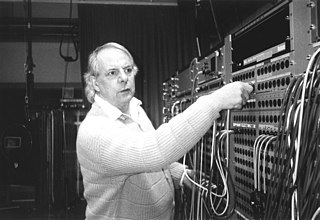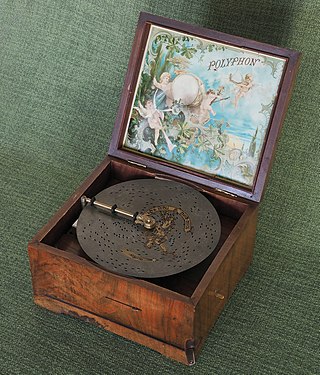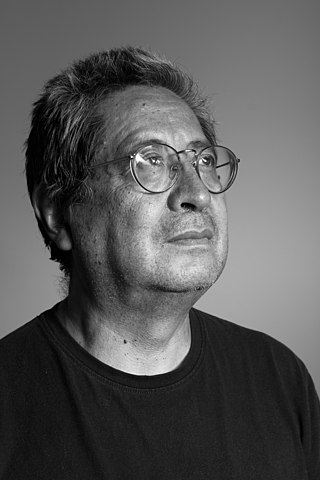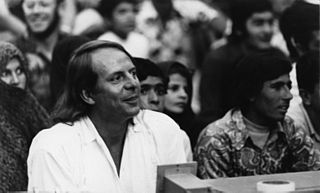Related Research Articles

Karlheinz Stockhausen was a German composer, widely acknowledged by critics as one of the most important but also controversial composers of the 20th and early 21st centuries. He is known for his groundbreaking work in electronic music, having been called the "father of electronic music", for introducing controlled chance into serial composition, and for musical spatialization.
20th-century classical music is art music that was written between the years 1901 and 2000, inclusive. Musical style diverged during the 20th century as it never had previously, so this century was without a dominant style. Modernism, impressionism, and post-romanticism can all be traced to the decades before the turn of the 20th century, but can be included because they evolved beyond the musical boundaries of the 19th-century styles that were part of the earlier common practice period. Neoclassicism and expressionism came mostly after 1900. Minimalism started much later in the century and can be seen as a change from the modern to postmodern era, although some date postmodernism from as early as about 1930. Aleatory, atonality, serialism, musique concrète, electronic music, and concept music were all developed during the century. Jazz and ethnic folk music became important influences on many composers during this century.
Contemporary classical music is Western art music composed close to the present day. At the beginning of the 21st century, it commonly referred to the post-1945 modern forms of post-tonal music after the death of Anton Webern, and included serial music, electronic music, experimental music, and minimalist music. Newer forms of music include spectral music, and post-minimalism.

Process music is music that arises from a process. It may make that process audible to the listener, or the process may be concealed.

A music box or musical box is an automatic musical instrument in a box that produces musical notes by using a set of pins placed on a revolving cylinder or disc to pluck the tuned teeth of a steel comb. The popular device best known today as a "music box" developed from musical snuff boxes of the 18th century and were originally called carillons à musique. Some of the more complex boxes also contain a tiny drum and/or bells in addition to the metal comb.
Karel August Goeyvaerts was a Belgian composer.
Formula composition is a serially derived technique encountered principally in the music of Karlheinz Stockhausen, involving the projection, expansion, and Ausmultiplikation of either a single melody-formula, or a two- or three-voice contrapuntal construction.

Darmstadt School refers to a group of composers who were associated with the Darmstadt International Summer Courses for New Music from the early 1950s to the early 1960s in Darmstadt, Germany, and who shared some aesthetic attitudes. Initially, this included only Pierre Boulez, Bruno Maderna, Luigi Nono, and Karlheinz Stockhausen, but others came to be added, in various ways. The term does not refer to an educational institution.
Friedrich Goldmann was a German composer and conductor.

Tierkreis (1974–75) is a musical composition by the German composer Karlheinz Stockhausen. The title is the German word for Zodiac, and the composition consists of twelve melodies, each representing one sign of the zodiac.
Boudewijn Buckinx is a Belgian composer and writer on music.

Mesías Maiguashca is an Ecuadorian composer and an advocate of Neue Musik, especially electroacoustic music.

Hans-Jürgen von Bose is a German composer.

Originale, musical theatre with Kontakte, is a music theatre work by the German composer Karlheinz Stockhausen, written in collaboration with the artist Mary Bauermeister. It was first performed in 1961 in Cologne, and is given the work number 12⅔ in Stockhausen's catalogue of works.
Sonata for Two Pianos (1950–51), also called simply Opus 1 or Nummer 1, is a chamber music work by Belgian composer Karel Goeyvaerts, and a seminal work in the early history of European serialism.
Spatial music is composed music that intentionally exploits sound localization. Though present in Western music from biblical times in the form of the antiphon, as a component specific to new musical techniques the concept of spatial music was introduced as early as 1928 in Germany.
In music, the Cologne School is a loosely associated group of composers and performers of the generation that came to prominence in the 1970s, who lived and worked in the city of Cologne, Germany.

The Oeldorf Group was a musicians' collective active in Germany in the 1970s. Based in the village of Oeldorf, near Cologne, their performances emphasized live-electronic music.

Für kommende Zeiten is a collection of seventeen text compositions by Karlheinz Stockhausen, composed between August 1968 and July 1970. It is a successor to the similar collection titled Aus den sieben Tagen, written in 1968. These compositions are characterized as "Intuitive music"—music produced primarily from the intuition rather than the intellect of the performer(s). It is work number 33 in Stockhausen's catalog of works, and the collection is dedicated to the composer's son Markus.
Michael Svoboda is an American composer and trombonist who lives and works in Switzerland.
References
- ↑ Reimann 1979, p. 25.
- ↑ Faltin 1979, p. 192.
- ↑ Andraschke 1981, pp. 126, 137–41.
- ↑ Gruhn 1981, pp. 185–186.
- ↑ Williams 2006, p. 384.
- ↑ Fox 2007, p. 31.
- ↑ Kapko-Foretić 1980, p. 50.
- ↑ Fox 2007, pp. 27–28.
- ↑ Rickards 2002, pp. 50–51.
- ↑ Beyer 2001.
- ↑ Jakobsen 2001.
- ↑ Fisk 1994, p. 402.
- ↑ Schubert 2001.
Cited sources
- Andraschke, Peter. 1981. “Kompositorische Tendenzen bei Karlheinz Stockhausen seit 1965”. In Kolleritsch 1981, 126–43.
- Beyer, Anders. 2001. "Abrahamsen, Hans." The New Grove Dictionary of Music and Musicians, second edition, edited by Stanley Sadie and John Tyrrell. London: Macmillan Publishers.
- Faltin, Peter. 1979. “Über den Verlust des Subjekts in der neuen Musik: Anmerkungen zum komponieren am Ausgang der 70er Jahre.” International Review of the Aesthetics and Sociology of Music 10, no. 2. (December): 181–98.
- Fisk, Josiah. 1994. "The New Simplicity: The Music of Górecki, Tavener and Pärt". Hudson Review 47, no. 3 (Fall): 394–412.
- Fox, Christopher. 2007. "Where the River Bends: The Cologne School in Retrospect". The Musical Times 148, no. 1901 (Winter): 27–42.
- Gruhn, Wilfried. 1981. "'Neue Einfachheit'? Zu Karlheinz Stockhausens Melodien des Tierkreis". Reflexionen uber Musik heute: Texte und Analysen, edited by Wilfried Gruhn, 185–202. Mainz, London, New York, and Tokyo: B. Schott's Söhne. ISBN 3-7957-2648-4.
- Jakobsen, Erik H. A. 2001. "Gudmundsen-Holmgreen, Pelle". The New Grove Dictionary of Music and Musicians, second edition, edited by Stanley Sadie and John Tyrrell. London: Macmillan Publishers.
- Kapko-Foretić, Zdenka. 1980. "Kölnska škola avangarde". Zvuk: Jugoslavenska muzička revija, 1980 no. 2:50–55.
- Reimann, Aribert. 1979. "Salut für die junge Avantgarde." Neue Zeitschrift für Musik 140, no. 1:25.
- Rickards, Guy. 2002. "Christopher Fox: Straight Lines in Broken Times; Chant suspendu; Generic Compositions #3, #4, & #5; Inner. Andrew Keeling: Quickening the Dead; Unseen Shadows; In the Clear; One Flesh; Tjam; O Ignis Spiritus; Off the Beaten Track. George Nicholson: Spring Songs; Three Pieces from Mots justes; Nodus; Letters to the World. Geoffrey Poole: The Impersonal Touch; Septembral; String Quartet No. 3; Firefinch. Anthony Powers: Fast Colours; Double Sonata; In the Sunlight; Quintet; Another Part of the Island. David Stoll: Piano Quartet, Piano Sonata, Sonata for 2 Pianos, String Trio. 'Rush': Mackey: Feel so Baaad; Wesley-Smith: For Marimba and Tape; Glentworth: Blues for Gilbert; Instrall: Chasm, Relate; Horne: Rush; Hellawell: Let's Dance". Tempo, new series, no. 222 (October): 48–49+51–53.
- Schubert, Giselher. 2001. "Germany, Federal Republic of I: Art Music, §5: Since 1918". The New Grove Dictionary of Music and Musicians, second edition, edited by Stanley Sadie and John Tyrrell. London: Macmillan Publishers.
- Williams, Alastair. 2006. "Swaying with Schumann: Subjectivity and Tradition in Wolfgang Rihm's Fremde Szenen I–III and Related Scores". Music and Letters 87, no. 3:379–97.